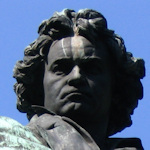
Beethoven lived in numerous Viennese houses and apartments, drank coffee and ate in numerous cafés and restaurants, and performed in various establishments. Some are still around, today. Many are not.
Discover the most prominent surviving locations with this guide and map, which includes photos and articles so you can tour Vienna and follow in the footsteps of one of the world’s greatest composers.
- The top two addresses:
- The Beethoven Museum
- Zentralfriedhof cemetery (for his grave)
- Book a concert experience* for Vienna
- See also:
Jump to sections on Beethoven’s…
- Life (residences, grave, biographical museums, etc)
- Music (venues where he appeared)
- Memorials (statues, memorabilia etc.)
Special exhibitions
Vienna often has temporary events focused on some aspect of Beethoven. For example:
- Joy, a Shining Divine Spark (May 1st to July 1st, 2024): an opportunity at the Theatermuseum to see excerpts from the original manuscript for the ninth symphony
Beethoven: his life
Beethoven made his name in Vienna, spending around 35 years in the city from 1792 until his death here in 1827. Dozens of addresses have some kind of connection to his life…not least the two locations where he was buried (yep, two).
The Beethoven museum
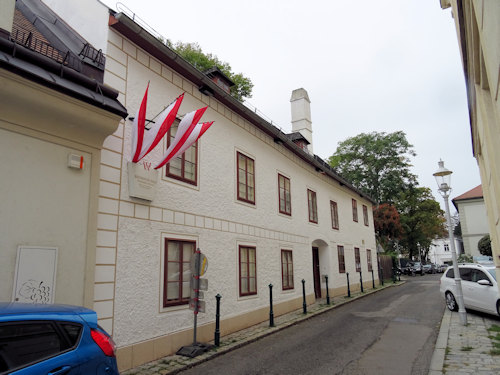
(The top address in Vienna for Beethoven fans)
Since Beethoven was born in Bonn (Germany), you’re not going to find his birthplace anywhere nearby. But plenty of other locations in Vienna have a strong relationship to the composer’s life. Let us begin with the most important…
The Beethoven Museum is a lovely musical museum in what is presumed to be the very house that Beethoven wrote the famous Heiligenstädter Testament (and his third symphony).
Pasqualatihaus
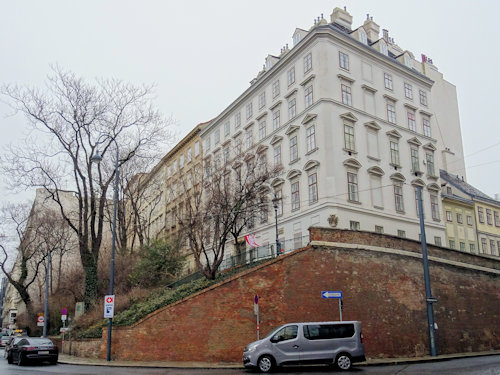
(This would have once been the very edge of the city)
Beethoven produced his opera, Fidelio, in this house atop the old city fortifications. A small museum there does not compete with the main Beethoven Museum, but it gives you a feel for the kind of environment he once lived and composed in.
Grinzinger Straße
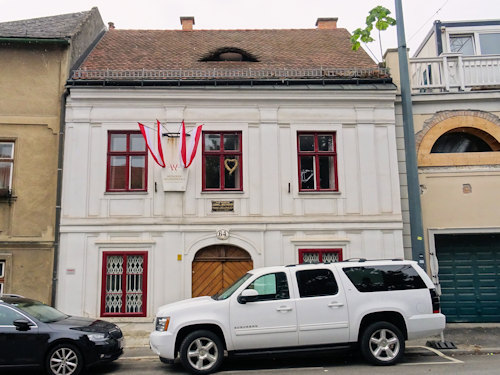
(You can’t go inside, unfortunately)
Known as the Beethoven-Grillparzer House, this private residence once echoed to the music of the maestro and the words of Franz Grillparzer, one of Austria’s greatest writers. Both lodged there in 1808.
Tiefer Graben 10-12
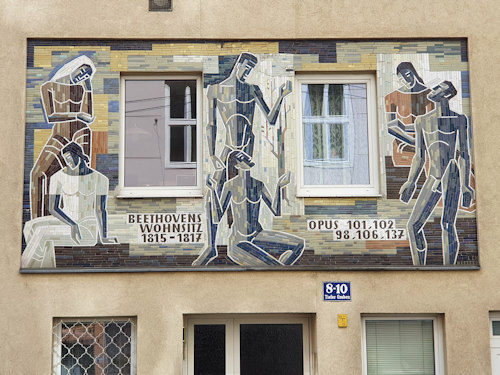
(The inscription lists several works presumably composed during his residence)
No longer the original building, but a large mural indicates that Beethoven lived at this address between 1815 and 1817.
Landstraße Hauptstraße 26
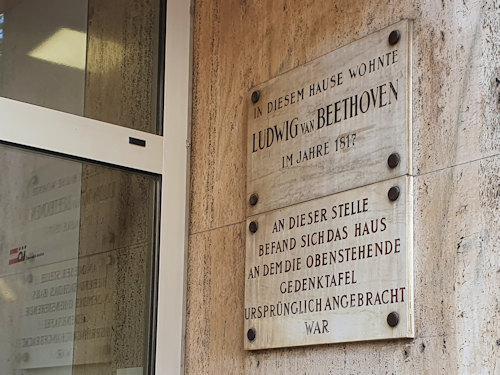
(The plaque hangs outside the entrance to the ÖIF – Österreichische Integrationsfonds)
Another former home of Beethoven, though the original building is also no more.
What has survived is the plaque that used to adorn the building, which simply states that he lived in that house in 1817.
Laimgrubengasse 22
Beethoven lived at this address in Vienna’s 6th district in 1822/1823, where he worked on, for example, his ninth symphony and Missa solemnis.
On the ground floor of this private building, you’ll find a suitable plaque and the rather apt Ludwig Van restaurant.
Ungargasse 5
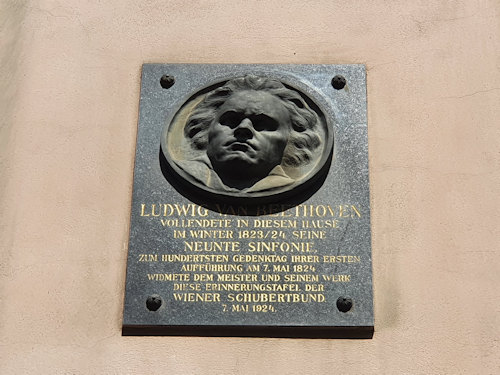
(Commemorating the genesis of what many consider Beethoven’s greatest work)
A plaque and relief on the wall indicates that Beethoven finished his Ninth Symphony here in the winter of 1823/1824.
The Wiener Schubertbund put up the stone tablet on May 7th, 1924 (the 100th anniversary of the symphony’s premiere)
Haydnhaus
As you might guess from the name, this was the last residence of Joseph Haydn in Vienna: literally the Haydn House. Now a museum, Beethoven visited the old master here.
Schwarzspanierhaus

(The plaque on the new building)
Beethoven died in his apartment on this site on March 26th, 1827.
The original house has gone, but the “new” one from the early 1900s has reliefs and plaques paying testament to the location’s historical importance.
Alserkirche
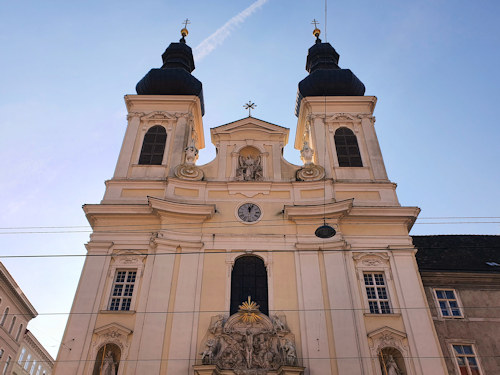
(Also known as the Church of the Holy Trinity)
The funeral cortege left the apartment on Schwarzspanierstraße and moved down to the Alserkirche for the funeral service on March 29th, accompanied by a crowd of thousands.
A plaque outside this early Baroque church commemorates the occasion.
Beethoven’s grave
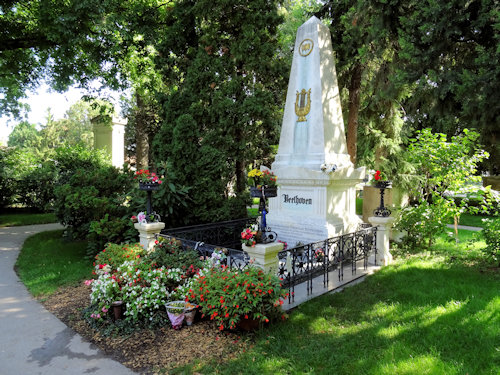
(Always accompanied by floral tributes)
When Beethoven died in 1827, they first buried him in the local Währinger cemetery before eventually moving the body to Vienna’s Zentralfriedhof cemetery.
Beethoven’s grave forms the centrepiece of a beautiful arrangement of composer graves that includes the Strauss family, Brahms, Gluck, and Schubert.
Beethoven: his music
Palais Lobkowitz

(The palais went up in the 1600s)
Beethoven enjoyed the support of wealthy sponsors, particularly Count Franz Joseph Maximilian von Lobkowitz.
Not only was our composer a regular guest at the count’s home, Palais Lobkowitz, but he also performed and premiered works there.
You can visit this Baroque palais (now Vienna’s Theatermuseum) and go into the room where Beethoven’s third (Eroica) symphony first saw the light of day and his fourth symphony was also performed before the public got to hear it.
The Theatermuseum actually offers an audio guide tour with a special focus on the building’s history, architecture, and musical & artistic connections.
Theater an der Wien

(The Theater an der Wien as it would have looked around 1816 during Beethoven’s lifetime. Painted by Jakob Alt; Wien Museum Inv.-Nr. 15589; excerpt reproduced with permission under the terms of the CC0 licence)
Still a major opera house in Vienna, the Theater an der Wien hosted the premiere of Fidelio and three symphonies, for example. Beethoven even lived and worked here for a time.
Palais Niederösterreich
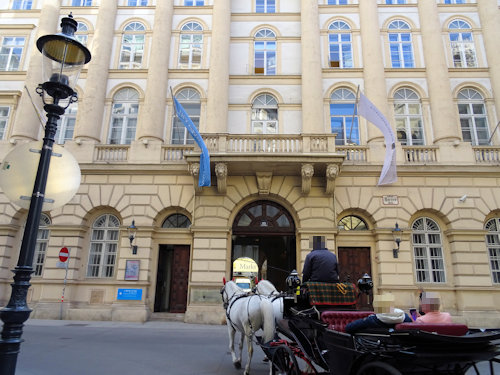
(Architectural treats inside date back as far as the Renaissance)
Beethoven apparently conducted a performance in this historical building in 1825. The Palais is a beautiful old city palace that only opens fully to the public on rare occasions.
Augarten Saal
Another surviving venue, now a café and a tract of the Augarten porcelain manufactury. A plaque outside the Saal notes that Beethoven premiered the Kreutzer Sonata here in 1803. Mozart and Schubert also performed at the same location.
Himmelpfortgasse 6
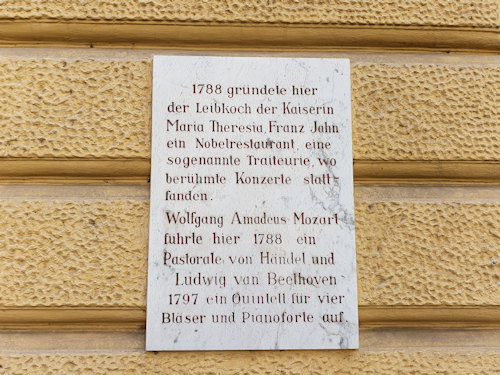
(Mozart also performed here in 1788)
A plaque on the building that now houses Café Frauenhuber explains that Ludwig van Beethoven premiered a quintet for pianoforte and brass here in 1797. Mozart performed there just 11 years earlier.
The Frauenhuber coffee house actually opened for business while Beethoven still lived.
Beethoven: memorials & more
Beethoven statue
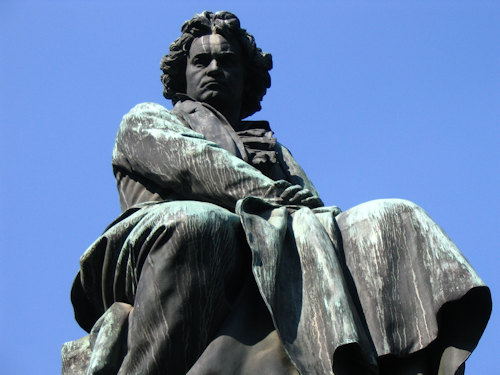
(The same sculptor also did the giant Maria Theresa monument)
Vienna’s main monument to the master is a large bronze statue unveiled in 1880.
The Beethoven statue sits in what you might call the music quarter, full of those great venues that still put on performances of his works today.
Haus der Musik

(Also find galleries dedicated to Strauss, Schubert, Mahler, Mozart and others)
This museum of music and sound has individual galleries dedicated to Vienna’s famous composers.
The Beethoven room, for example, includes a door from his final residence, numerous memorabilia, and a special multimedia installation exploring the process of his hearing loss.
Historical Musical Instrument Collection
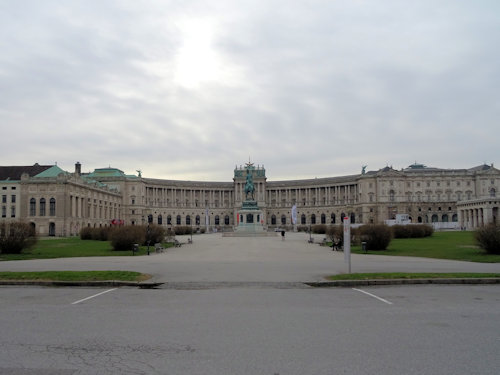
(The rather impressive Neue Burg wing of the Hofburg palace takes you through the evolution of instrument design with various pieces connected to famous composers)
No prizes for guessing what this part of Vienna’s Kunsthistorisches Museum displays.
Among the treasures is a fortepiano allegedly played by Beethoven himself and an 1823 portrait of the composer by the famous Biedermeier painter Ferdinand Georg Waldmüller.
Beethoven Frieze
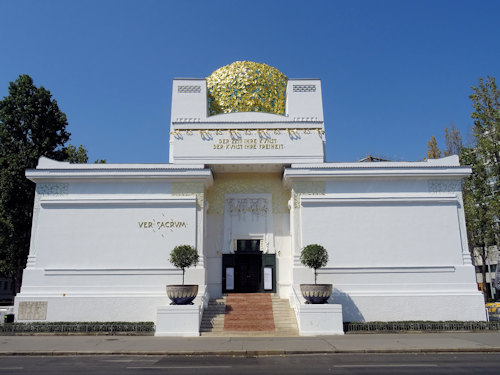
(A piece of classic Jugendstil architecture)
This huge Klimt wall painting lives below ground in the Secession art gallery. Klimt created the work for a 1902 art exhibition honouring the composer.
Beethoven-Hof
Probably not worth a visit. A 1930s council housing block at O’Brien-Gasse 26. The city renamed the complex in Beethoven’s honour in 2020.
Madame Tussauds
A little different to all the above, but the Vienna branch of the wax museum offers the chance for a selfie with the great composer.
(I’m researching more locations, so watch this space for updates on residences, in particular.)